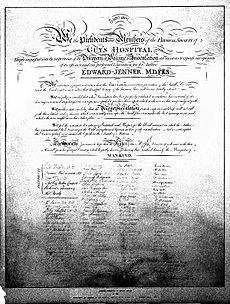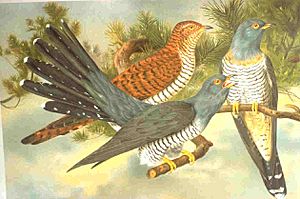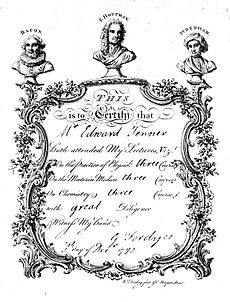Edward Jenner facts for kids
Quick facts for kids
Edward Jenner
|
|
|---|---|
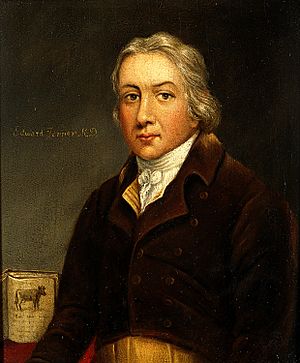
Edward Jenner oil painting
|
|
| Born | 17 May 1749 Berkeley, Gloucestershire, England
|
| Died | 26 January 1823 (aged 73) Berkeley, Gloucestershire, England
|
| Nationality | British |
| Alma mater |
|
| Known for | Smallpox vaccine Vaccination |
| Scientific career | |
| Fields | Medicine/surgery, natural history |
| Academic advisors | John Hunter |
Edward Jenner (born May 17, 1749 – died January 26, 1823) was an English doctor. He is famous for creating the world's first vaccine for smallpox. His work made vaccination popular. Since then, vaccines have been used to prevent many serious diseases.
Jenner's discovery saved countless lives. In his time, smallpox was a deadly disease. It killed about 10% of people in Britain. In towns and cities, this number could be as high as 20%. In 2002, the BBC named Jenner one of the 100 Greatest Britons.
Contents
Edward Jenner's Early Life
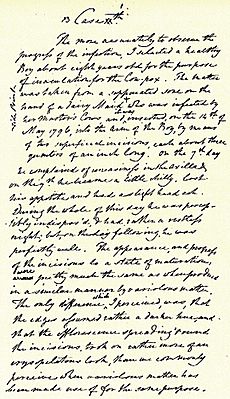
Edward Jenner was born on May 17, 1749, in Berkeley, Gloucestershire, England. He was the eighth of nine children. His father, Reverend Stephen Jenner, was the local church leader. This meant Edward received a good basic education.
His Education and Training
When he was young, Edward went to school in Wotton-under-Edge and Cirencester. During this time, he was given a mild form of smallpox to protect him. This old method was called variolation. It affected his health for the rest of his life.
At age 14, he began training for seven years with Daniel Ludlow. Ludlow was a surgeon in Chipping Sodbury. This training gave Jenner much of the experience he needed to become a surgeon.
In 1770, at 21, Jenner moved to London. He continued his training in surgery and anatomy at St George's Hospital. One of his teachers was the famous surgeon John Hunter. Hunter told Jenner, "Don't think; try." This meant he should experiment and observe, not just guess.
Hunter and Jenner stayed in touch. Hunter even suggested Jenner for the Royal Society. By 1773, Jenner returned home. He became a successful family doctor and surgeon in Berkeley. In 1792, after 20 years of practice, he earned his MD degree from the University of St Andrews.
Later Years and Medical Groups
Jenner and other doctors formed the Fleece Medical Society. They met at the Fleece Inn in Rodborough. Members would eat together and discuss medical topics. Jenner wrote papers on heart problems and eye diseases. He also talked about cowpox, which would later be very important. He was also part of a similar group in Alveston.
Jenner became a master mason in 1802. He even led his local lodge from 1812 to 1813.
Jenner's Interest in Animals
Jenner was chosen to join the Royal Society in 1788. This was after he published a detailed study about the cuckoo bird. Before his work, people did not fully understand how cuckoos lived. Jenner's study involved watching, experimenting, and examining the birds.
Jenner discovered that a newly hatched cuckoo chick pushes the eggs and other baby birds out of its host's nest. People used to think the adult cuckoo did this. Jenner showed that the baby cuckoo has a special dip in its back. This dip helps it scoop up eggs and other chicks. This dip disappears after about 12 days. The adult cuckoo does not stay long enough to do this job. Jenner's findings were published in 1788.
His detailed observations helped others understand animal behavior. Later, an artist named Jemima Blackburn saw a blind cuckoo chick pushing out an egg. Her drawings and description helped convince Charles Darwin to update his book, On the Origin of Species.
Jenner's interest in animals was key to his vaccine discovery. He understood both human and animal bodies. He saw how diseases could pass between animals and humans. This connection is now known to be very important for vaccines. Many modern vaccines still use animal parts, like those from cows or chickens. This idea started with Jenner's work on cowpox and smallpox.
Family Life and Medical Discoveries
Jenner married Catherine Kingscote in March 1788. She sadly died in 1815 from tuberculosis, a serious lung disease. They had three children: Edward Robert, Robert Fitzharding, and Catherine.
He received his MD from the University of St Andrews in 1792. He also helped improve the understanding of angina pectoris, a type of chest pain. He wrote that the heart suffers when its blood vessels cannot work properly.
The Smallpox Vaccine
The idea of vaccination was not entirely new before Jenner. In 1765, Dr. John Fewster wrote about cowpox preventing smallpox. But he did not continue his research.
Before Jenner, at least five other people in England and Germany had successfully used cowpox to protect humans from smallpox. For example, in 1774, farmer Benjamin Jesty vaccinated his wife and children with cowpox during a smallpox outbreak. Jenner might have known about Jesty's success. But it was Jenner's work, 20 years later, that made the method widely known.
It was a common belief that milkmaids rarely got smallpox. Jenner thought this was because they often caught cowpox from cows. Cowpox was a milder disease, similar to smallpox but much less dangerous. He believed the pus from cowpox blisters protected them.
On May 14, 1796, Jenner decided to test his idea. He took pus from cowpox blisters on a milkmaid's hand. He then put this pus into the arms of an eight-year-old boy named James Phipps. James got a fever and felt a bit unwell, but he did not get a full cowpox infection. Later, Jenner gave James a mild form of smallpox. James showed no signs of infection. Jenner had successfully protected him! He then tested his idea on 23 more people, with similar success.
Later Life and Recognition
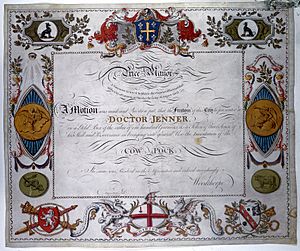
Jenner received many honors for his work. He became an honorary member of the American Academy of Arts and Sciences in 1802. He also joined the American Philosophical Society in 1804 and the Royal Swedish Academy of Sciences in 1806.
In 1803, he became president of the Jennerian Society in London. This group worked to promote vaccination and get rid of smallpox. In 1808, the government helped create the National Vaccine Establishment. Jenner was not happy with the people chosen to run it, so he resigned.
In 1811, Jenner saw some cases of smallpox in people who had been vaccinated. He noticed that their illness was much less severe because they had been vaccinated. In 1821, he became a special doctor to King George IV. He was also made mayor of Berkeley and a local magistrate. He continued to study animals, and in 1823, he shared his observations on bird migration with the Royal Society.
His Death
On January 25, 1823, Jenner was found unwell. He had a stroke, which left his right side paralyzed. He did not get better and died the next day, January 26, 1823, at age 73. He was buried in his family's burial place at the Church of St Mary in Berkeley.
Monuments and Places Honoring Jenner
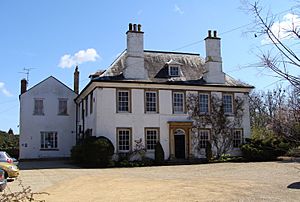
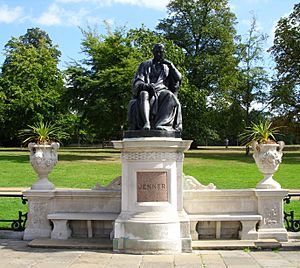
Many places and monuments honor Edward Jenner:
- Jenner's home in Berkeley, Gloucestershire, is now a small museum. It even has the horns of Blossom, the cow linked to his discovery!
- A statue of Jenner is in the Gloucester Cathedral.
- Another statue was first in Trafalgar Square and later moved to Kensington Gardens in London.
- Near Uley, England, a hill is called "Smallpox Hill." This is because it might have been part of Jenner's studies.
- London's St. George's Hospital Medical School has a Jenner Pavilion.
- Several places in Somerset County, Pennsylvania, USA, are named after him. These include Jenners, Jenner Township, Jenner Crossroads, and Jennerstown, Pennsylvania.
- Jennersville, Pennsylvania, is in Chester County.
- The Edward Jenner Institute for Vaccine Research is a center for vaccine research. It is also part of the University of Oxford.
- A section at Gloucestershire Royal Hospital is called the Edward Jenner Unit.
- A ward at Northwick Park Hospital is called Jenner Ward.
- Jenner Gardens in Cheltenham, Gloucestershire, is a small garden and cemetery.
- A statue of Jenner was put up at the Tokyo National Museum in 1896. This was 100 years after his vaccine discovery.
- There is a monument outside the walls of Boulogne sur Mer, France.
- A street in north London is called Jenner Road.
- The Jenner Health Centre in Forest Hill, London, was built around 1970.
- Jenner's name is on the Frieze of the London School of Hygiene & Tropical Medicine. His name is one of 23 pioneers chosen for the building in 1926.
- A small planet, 5168 Jenner, is named in his honor.
Images for kids
-
Jenner performing his first vaccination on James Phipps, an 8-year-old boy, on May 14, 1796.
-
James Gillray's 1802 cartoon of Jenner vaccinating patients. They feared it would make them grow cow-like parts.
-
An 1808 cartoon showing Jenner, Thomas Dimsdale, and George Rose saying goodbye to people against vaccination.
-
An 1825 memorial to Jenner by Robert William Sievier, in Gloucester Cathedral.
See also
 In Spanish: Edward Jenner para niños
In Spanish: Edward Jenner para niños


